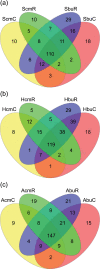Soil bacterial community structure responses to precipitation reduction and forest management in forest ecosystems across Germany
- PMID: 25875835
- PMCID: PMC4397059
- DOI: 10.1371/journal.pone.0122539
Soil bacterial community structure responses to precipitation reduction and forest management in forest ecosystems across Germany
Erratum in
-
Correction: Soil bacterial community structure responses to precipitation reduction and forest management in forest ecosystems across Germany.PLoS One. 2015 Apr 30;10(4):e0127608. doi: 10.1371/journal.pone.0127608. eCollection 2015. PLoS One. 2015. PMID: 25928746 Free PMC article. No abstract available.
Abstract
Soil microbial communities play an important role in forest ecosystem functioning, but how climate change will affect the community composition and consequently bacterial functions is poorly understood. We assessed the effects of reduced precipitation with the aim of simulating realistic future drought conditions for one growing season on the bacterial community and its relation to soil properties and forest management. We manipulated precipitation in beech and conifer forest plots managed at different levels of intensity in three different regions across Germany. The precipitation reduction decreased soil water content across the growing season by between 2 to 8% depending on plot and region. T-RFLP analysis and pyrosequencing of the 16S rRNA gene were used to study the total soil bacterial community and its active members after six months of precipitation reduction. The effect of reduced precipitation on the total bacterial community structure was negligible while significant effects could be observed for the active bacteria. However, the effect was secondary to the stronger influence of specific soil characteristics across the three regions and management selection of overstorey tree species and their respective understorey vegetation. The impact of reduced precipitation differed between the studied plots; however, we could not determine the particular parameters being able to modify the response of the active bacterial community among plots. We conclude that the moderate drought induced by the precipitation manipulation treatment started to affect the active but not the total bacterial community, which points to an adequate resistance of the soil microbial system over one growing season.
Conflict of interest statement
Figures





Similar articles
-
Differential sensitivity of total and active soil microbial communities to drought and forest management.Glob Chang Biol. 2017 Oct;23(10):4185-4203. doi: 10.1111/gcb.13790. Epub 2017 Jul 6. Glob Chang Biol. 2017. PMID: 28614633
-
Mineral Types and Tree Species Determine the Functional and Taxonomic Structures of Forest Soil Bacterial Communities.Appl Environ Microbiol. 2017 Feb 15;83(5):e02684-16. doi: 10.1128/AEM.02684-16. Print 2017 Mar 1. Appl Environ Microbiol. 2017. PMID: 28003192 Free PMC article.
-
Soil microbial community response to drought and precipitation variability in the Chihuahuan Desert.Microb Ecol. 2009 Feb;57(2):248-60. doi: 10.1007/s00248-008-9475-7. Epub 2008 Dec 9. Microb Ecol. 2009. PMID: 19067031
-
[Responses of forest soil microbial communities to drought and nitrogen deposition: A review].Ying Yong Sheng Tai Xue Bao. 2020 Jul;31(7):2464-2472. doi: 10.13287/j.1001-9332.202007.035. Ying Yong Sheng Tai Xue Bao. 2020. PMID: 32715714 Review. Chinese.
-
The functional role of temperate forest understorey vegetation in a changing world.Glob Chang Biol. 2019 Nov;25(11):3625-3641. doi: 10.1111/gcb.14756. Epub 2019 Aug 26. Glob Chang Biol. 2019. PMID: 31301199 Review.
Cited by
-
Responses of soil bacterial communities to precipitation change in the semi-arid alpine grassland of Northern Tibet.Front Plant Sci. 2022 Oct 17;13:1036369. doi: 10.3389/fpls.2022.1036369. eCollection 2022. Front Plant Sci. 2022. PMID: 36325540 Free PMC article.
-
Climate and Soil Microsite Conditions Determine Local Adaptation in Declining Silver Fir Forests.Plants (Basel). 2023 Jul 10;12(14):2607. doi: 10.3390/plants12142607. Plants (Basel). 2023. PMID: 37514222 Free PMC article.
-
Deprivation of root-derived resources affects microbial biomass but not community structure in litter and soil.PLoS One. 2019 Mar 28;14(3):e0214233. doi: 10.1371/journal.pone.0214233. eCollection 2019. PLoS One. 2019. PMID: 30921392 Free PMC article.
-
Correction: Soil bacterial community structure responses to precipitation reduction and forest management in forest ecosystems across Germany.PLoS One. 2015 Apr 30;10(4):e0127608. doi: 10.1371/journal.pone.0127608. eCollection 2015. PLoS One. 2015. PMID: 25928746 Free PMC article. No abstract available.
-
Viral but not bacterial community successional patterns reflect extreme turnover shortly after rewetting dry soils.Nat Ecol Evol. 2023 Nov;7(11):1809-1822. doi: 10.1038/s41559-023-02207-5. Epub 2023 Sep 28. Nat Ecol Evol. 2023. PMID: 37770548
References
-
- IPCC. Summary for Policymakers: Managing the Risks of Extreme Events and Disasters to Advance Climate Change Adaptation In: Field CB, Barros V, Stocker TF, Qin D, Dokken DJ, Ebi KL, et al., editors. A Special Report of Working Groups I and II of the Intergovernmental Panel on Climate Change. Cambridge, UK: Cambridge University Press; 2012. p. 1–19.
-
- Allen CD, Macalady AK, Chenchouni H, Bachelet D, McDowell N, Vennetier M, et al. A global overview of drought and heat-induced tree mortality reveals emerging climate change risks for forests. For Ecol Manage. 2010;259: 660–684.
-
- Breda N, Huc R, Granier A, Dreyer E. Temperate forest trees and stands under severe drought: a review of ecophysiological responses, adaptation processes and long-term consequences. Ann Forest Sci. 2006;63: 625–644.
Publication types
MeSH terms
Substances
LinkOut - more resources
Full Text Sources
Other Literature Sources

